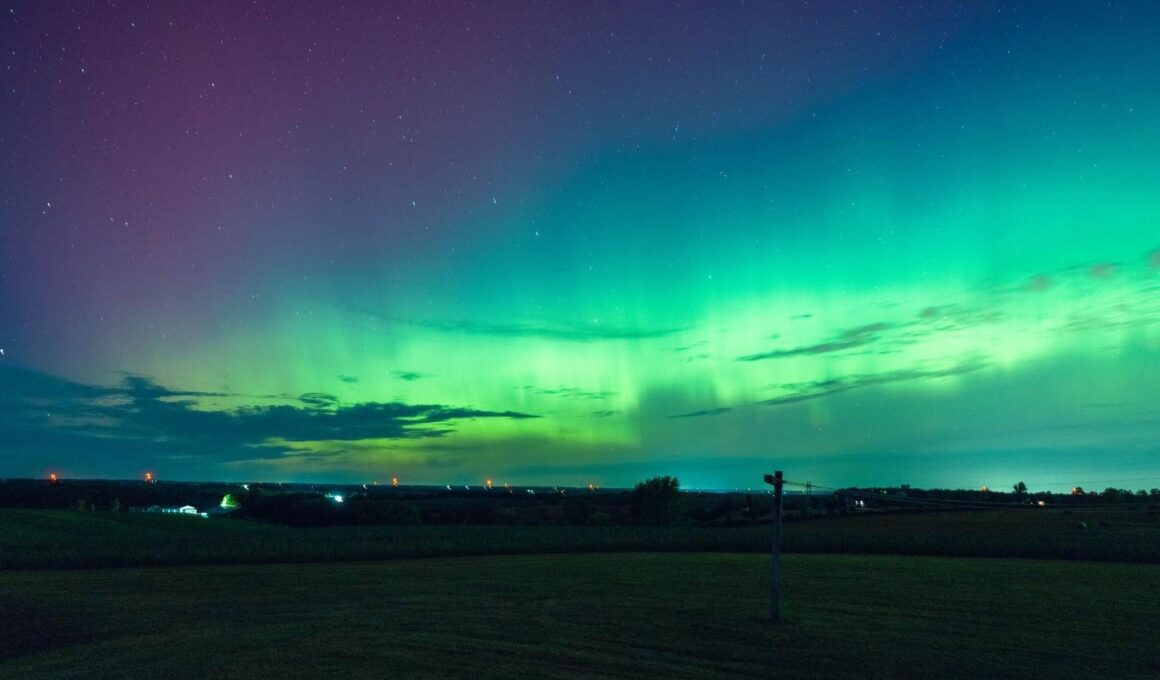Updated Northern Lights Forecast: Where To See Aurora Borealis Tonight As Perseids Continue
Topline
There may be a chance to see the Northern Lights and the Perseids—one of the most anticipated meteor showers of the year—again Monday night after scientists predict geomagnetic storm conditions may continue on into Tuesday.
Wisconsin’s night sky is glowing with the Northern Lights, as a geomagnetic storm is bringing … [+]
Key Facts
The National Oceanic and Atmospheric Administration released a Northern Lights forecast for this week, and it predicts geomagnetic storm conditions may persist into Tuesday, though space weather is unpredictable and it’s unsure how favorable solar conditions will be.
A group of coronal mass ejections—eruptions of solar material—arrived to Earth over the weekend, and CMEs are predicted to continue passing by until Tuesday, causing the aurora borealis to be visible in several continental U.S. states.
This comes after a strong G4 geomagnetic storm was observed Monday and had a Kp index that reached high level eight status—which were stronger conditions than previously expected—producing some of the strongest Northern Lights since May’s impressive show.
Monday night’s aurora borealis has a Kp index of six, meaning the lights will move even further from the poles and become “quite bright and active,” according to the National Oceanic and Atmospheric Administration.
The Perseid meteor shower peaked Sunday night into early Monday morning, and the aurora borealis was also visible during this time, causing a dazzling show for viewers.
Although the Perseids have already peaked, the popular meteor shower doesn’t end until September 1, and since the days right before and after the peak are prime viewing days, there’s a good chance the shower will be visible again Monday night.
Get Forbes Breaking News Text Alerts: We’re launching text message alerts so you’ll always know the biggest stories shaping the day’s headlines. Text “Alerts” to (201) 335-0739 or sign up here.
Where Will The Northern Lights Be Visible Tonight?
Though it’s difficult to know where the Northern Lights will show up, they may be the most visible Tuesday night in Canada and Alaska, according to NOAA (see image below). However, continental U.S. states within the aurora’s view line include Washington, Oregon, Idaho, Montana, Wyoming, North Dakota, South Dakota, Nebraska, Minnesota, Iowa, Wisconsin, Illinois, Michigan, New York, Vermont, New Hampshire and Maine.
Monday night’s aurora view line.
What’s The Best Way To See The Northern Lights?
The lights are typically the most active between 10 p.m. and 2 a.m. For the best views of the Northern Lights, the agency advises traveling as close to the poles as possible, avoiding city lights and other light pollution, monitoring weather forecasts for prime viewing conditions and finding a position on a vantage point like a hilltop.
What’s The Best Way To Photograph The Northern Lights?
Smartphone cameras are sensitive enough to pick up the aurora, even when it’s invisible to the naked eye. Visit Iceland, a tourist website for Iceland, where the lights are often visible, advises turning on night mode to best increase smartphone camera exposure.
Key Background
Solar Cycle 25—the cycle the sun goes through around every 11 years—has been the cause of geomagnetic storms that have resulted in recent sightings of the Northern Lights, and NASA predicts it will continue on into next year. Cycle 25 began in Dec. 2019, and it’s estimated it will reach its maximum—when activity is expected to peak— between late 2024 and early 2026. It’s projected to peak with 115 sunspots, which are where geomagnetic storms originate. Although the maximum hasn’t happened yet, the sun’s activity has been busier than scientists anticipated, so it’s possible there will be even more geomagnetic storms leading up to 2025, though it’s difficult to predict exactly when these storms will occur.
Surprsing Fact
Solar Cycle 25 likely reached its highest sunspot number on August 8 since the cycle began, according to NOAA. Though the official number won’t be available until the end of August, NOAA predicts it peaked with almost 300 sunspots. This is the highest number since at least July 2002.
Section Title
Northern Lights And Perseid Meteor Shower Put On A Celestial Show Overnight (Photos) (Forbes)
Perseid Meteor Shower: Why Astronomers Recommend Putting Your Phone Away For This Weekend’s Show (Forbes)









